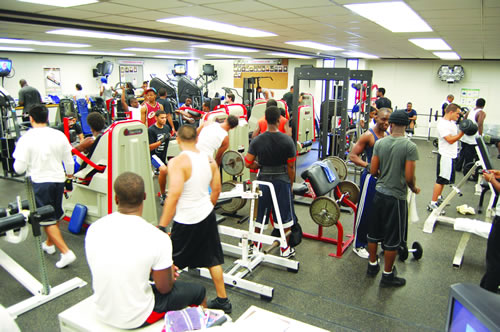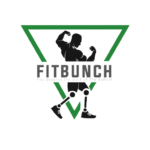
It’s January right now, and fortunately the gym is a pretty popular place to be. While it’s great to see so many people taking the plunge and changing their lives for the better, it can be a little bit hectic and crazy, especially if you’re hitting it during peak times (the “after work crowd” starts showing up about 430pm and runs til 7pm). Needless to say this can make getting in a planned workout quite difficult. No matter how big your gym is, it never seems quite large enough when these busier times come around. If you’re a seasoned gym-goer you’re used to it by now, but cutting corners on your workout for lack of available equipment is a terrible route to take. On the other side of the coin, if you’re a new gym member looking to get a great workout, it can be quite intimidating with minimal available equipment – you might be tempted to relegate yourself to the treadmill, or worse yet “bail until this place calms down!” Thankfully, with some forethought and unique execution, you can still manage to get a fantastic workout even in a packed gym. Over my years as both a member and trainer at various-sized commercial and private fitness facilities, I’ve accrued quite a collection of unique methods of training when there’s slim pickings for equipment… Check some of them out below!
Bodyweight Training
Bodyweight training gets a bad rap because “you can’t build muscle like that” or, more frequently, people are apprehensive about the perceptions of those around them – getting the idea that bodyweight training is out of the “norm” and may look weird. Performing bodyweight and calisthenic exercises with the right intensity is an astonishingly great way to get a good workout in. Movements like squats, lunges, push-ups, planks, and all of their MANY variations are great to familiarize yourself with because not only are they fundamental, but with the right level of intensity they can pave the way for a tortuously good workout – especially if you’re used to barbell or circuit machine-based training. Now, as far as intensity goes – a few ideas to freshen things up – these apply to all styles of training listed in this article, but we’ll cover them now.
- Higher volume – If you’re used to typical barbell training, you more than likely perform 2 or 3 sets of anywhere between 5-15 repetitions. That’s fine, but to provoke stimulation from bodyweight training, we will need to take things up a notch (provided you’re able to do so with good form) – try to work in the neighborhood of 15-25 reps with bodyweight based movements, as well as increasing the number of sets (if you usually do 2 or 3 sets of a lower rep barbell movement, 3 or 4 sets of high rep bodyweight training will TOAST you!)
- Circuit training – Easy enough, right? Many of us do our set, step back from the barbell, or sit on the bench for a few minutes either gazing off into space, checking our phones, or chatting with a fellow gym-goer. If you’re looking to juice up your workout, circuit training (performing multiple rounds of different movements with little or no rest between) may be just the trick.
- Fun with acute variables – we’ve touched on sets and reps, but there are many more controllables when it comes to our workouts, like rep tempo, rest periods, and overall intensity.
Dumbbell/Kettlebell Training
Around this time of year, especially during those “busy hours,” it’s pretty common for me to walk with a client to the gym’s free weight area, see an immense amount of people crawling all over each other with no squat racks, bench presses, or free benches available. Typically this will result in my client and I looking at each other, saying “Hell no” and grabbing a pair of dumbbells before finding a corner to work in. Thankfully, pretty much any barbell movement has an equal or superior dumbbell counterpart, which when performed with adequate intensity, does the job just as well. Dumbbell movements test stability and balance differently, and are generally able to be performed in a more limited amount of space than their barbell counterparts. They can also be performed with alternating (switching which side of the body the movement is being executed on) or isometric movements (i.e. holding a dumbbell at the “top” of a bicep curl while performing repetitions with the other hand) – which can definitely kick up the intensity!
Familiarizing yourself with kettlebell training is another excellent way to make the most of minimal equipment. Kettlebells can be pressed, pulled, carried, squatted, deadlifted, and so on with the same, if not more, effectiveness than traditional barbell movements. They also open your world to a number of unique movements such as the kettlebell swing, which functions as my go-to strength and conditioning maneuver, as well as more advanced movements like cleans, presses, and snatches, that would otherwise require weeks or months of coaching to safely perfect. Many of the same movements can be performed with dumbbells and kettlebells interchangeably, but the kettlebell has a little more versatility in my opinion.
Suspension Training
More and more gyms are getting outfitted with suspension training systems like the TRX Trainer, or Jungle Gym XT – become familiar with these implements, and they can become a great tool in your arsenal. Just like dumbbell/kettlebell training, bodyweight suspension training offers some great counterparts to traditional barbell movements. Your stability and proprioception will be challenged in ways you may not have experienced previously, and you will also have some new movements to add to your toolbox as you become more advanced. For example TRX ab movements – high planks, mountain climbers, and pikes simply can’t be performed to the same effect with your feet on a bench, and shoulder movements like I’s Y’s and T’s don’t offer the same challenge when performed with a dumbbell. Also, moving your body through space offers an additional challenge for your core.
K.I.S.S. and Have a Back-Up Plan
Keep it simple, stupid. Look, we all know that you “need” to squat and bench press, but there’s no use in hanging around wasting time and looking like a creep while you wait for a squat rack or bench to free up. If your typical leg day calls for back squats, front squats, sumo squats, and overhead squats – don’t count on it happening if the gym is busy. Also, Monday is commonly known as “international chest day” so if your program isn’t ridiculously strict on which days you hit which body parts, it’s worth jumbling some of the days around to maximize your time.
Having a back-up plan, or at least a few back-up movements prepared ahead of time is going to be incredibly handy. If you’re hitting the gym on leg day and every squat rack is taken, think of the other squat variations you can utilize – dumbbell squats, goblet squats, sumo dumbbell squats, single-leg squat variations, and so on. If it’s chest day and you can’t find a bench, grab a stability ball and a pair of dumbbells to work with – you’ll experience a whole new challenge. Just be sure to compensate with some lighter weight, higher overall volume, and greater intensity.
Switch Up the Game
If all else fails, you can take a look at structuring your day a bit differently. Most people hit the gym on the way home from work for sake of convenience. Ask your gym’s front desk staff what the peak times are. Each commercial gym I’ve been to has a small but dedicated early morning crowd, and the same goes for late evenings. There’s also a lull during the “lunch hour” between 12-2pm, so if you’re close to work instead of spending your time “checking out” why not “check-in” to the gym?!
The last piece of advice I have for you, is to equip your own “home gym” – all of the implements I’ve mentioned above (dumbbells, kettlebells, TRX/JGXT, and Swiss/stability balls) can be acquired pretty readily for a minimal investment at any big-box retail store, and they don’t take up very much space at all. This is a phenomenal plan if you are self-motivated enough to get some time in with the same frequency and intensity that you would at the gym; however, this option should be reserved for those with an inherent motivation.
Hopefully these hints and tips I’ve offered above will help you get the most out of your workouts during this crazy-busy time of the year for gyms. Soon enough, things will be back to normal. In the meantime, find ways to leverage the situation to your advantage and continue getting the most out of your workouts! If you’re looking for something new and different to add to your workouts, consider getting a Workout Plan from the FitBunch shop. Your plan will be completely customized to your goals, schedule, and available equipment – enter code FBFAM at checkout for 15% off!
